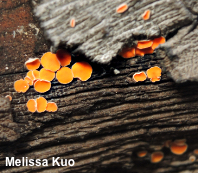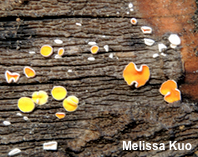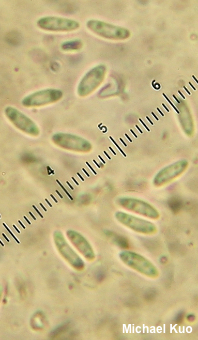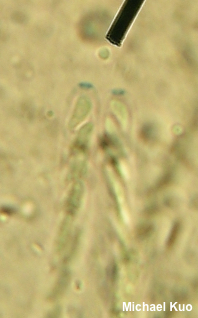| Major Groups > Cup Fungi > Lachnellula subtilissima |

|
Lachnellula subtilissima [ Ascomycota > Helotiales > Hyaloscyphaceae > Lachnellula ... ] by Michael Kuo These cup fungi may qualify as the tiniest mushrooms featured at this website (visible with the naked eye, that is; Gelatinopsis geoglossi is smaller but requires a microscope to see). The tiny fruiting bodies are only 1–3 millimeters across, and they'd be hard to see if it weren't for the fact that they are bright orange, and appear on the dark bark of conifers, providing stark contrast (the dark-bark-stark rhyme was made on a lark). The undersides of the cups are white and hairy—but good luck seeing that clearly with your unaided eyes. Believe it or not, there are several species that look just like Lachnellula subtilissima, and microscopic examination will be needed to identify them. Defining features for Lachnellula subtilissima include its spores, which are spindle-shaped and under 11 µm long—and the amyloid tips of its asci. Similar species differ in spore morphology or in the reaction of the ascus tips to iodine. Description: Ecology: Saprobic on the bark and wood of conifers; growing gregariously to densely gregariously; summer and fall; distributed in western North America in montane regions; also known from Europe and Australasia. The illustrated and described collection is from Colorado. Fruiting Body: Cup-shaped, becoming flattened with age; 1–3 mm across; without a stem. Upper Surface: Bright orange when fresh, fading to orangish yellow; bald. Undersurface: White; hairy. Flesh: Orangish; fairly brittle. Odor: Not distinctive. Microscopic Features: Spores 5.5–8 x 1.5–2 µm; subfusiform; sometimes a little curved; smooth; hyaline in KOH; often with a few small oil droplets. Asci 80–95 x 4–6 µm; 8-spored; tips amyloid (may require IKI, or soaking in KOH before mounting in Melzer's). Paraphyses 70–90 x 2–3 µm; cylindric below subclavate, straight apices; septate; smooth; with globular contents that are golden in KOH and amyloid in Melzer's. REFERENCES: (Cooke, 1875) Dennis, 1962. (Dharne, 1964; Breitenbach & Kränzlin, 1984; Baral, 2000; Hosoya et al., 2010.) Herb. Kuo 07261907. This site contains no information about the edibility or toxicity of mushrooms. |
© MushroomExpert.Com |
|
Cite this page as: Kuo, M. (2020, January). Lachnellula subtilissima. Retrieved from the MushroomExpert.Com Web site: http://www.mushroomexpert.com/lachnellula_subtilissima.html |



